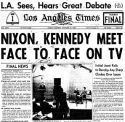 Yes, I’m on vacation, but that doesn’t mean I stop reading the news. Over the last few days, I’ve seen a number of articles that can be loosely tied together around historical themes:
Yes, I’m on vacation, but that doesn’t mean I stop reading the news. Over the last few days, I’ve seen a number of articles that can be loosely tied together around historical themes:
- Explaining Guns. If you’ve ever been to the Autry National Center in Griffith Park, you know that they have a large display of firearms. In the older part of the exhibit (if memory serves correct, it is after the singing cowboy room), these are just displayed. You can see the beauty of the weapons, but no historical context. According to the LA Times, that’s changing. The Autry is installing new exhibits that will place the weaponry in historical context, explaining the role of particular weapons in shaping the Western US. I really do need to get over and see that (I also need to see their exhibit on Jews in LA). The article also mentioned they might be getting rid of the exhibit on singing and movie cowboys — I hope they don’t do that (although it needs refreshing). For one, that period is nostalgic to many; more importantly, that period was a significant reflection of the morés of the times — it showed beliefs and stereotypes — that still influence our culture today (both in a positive and negative sense).
- Would You Like Fries With That? I can’t stand ketchup (catsup). Not on fries. Not on burgers. Not on anything. But I know people that love it. I’m sure that most people don’t know the history of the condiment — for example, that it was once a fish sauce, and very dangerous to eat. How did that change? Thank a man named Heinz, who believed so much in the purity of his product that he put it in transparent containers. For those that enjoy ketchup, you’ll get a kick out of this article.
- Shall I Grind It For You? No, I’m not talking about Miley Cyrus at the VMA. Rather, I’m continuing on the condiment theme of the last bullet. This time, the subject is black pepper, and the question is: Why do they grind pepper at the table? Curious? Here’s the answer. The origin is similar to the Heinz story: to demonstrate purity of product.
- Believing What You See. The last two items have a common thread: If you see it, you know its true. Is that always true? The answer, alas, is no. Here’s an interesting article (h/t Andrew Ducker) on photomanipulation through the years — it didn’t start with photoshop, but goes back to the early days of photography. If you don’t want all the links in that article, here’s a shorter summary with clearer examples.
- Saving a Sign. We’ll bookend these bullets with another item about historical Los Angeles. They will soon be demolishing the Tiffany Theatre on Sunset Blvd, and Valley Relics is going to be saving the sign (at the rate Valley Relics is going, they will soon have a sign boneyard to rival Vegas). If you don’t recognize the Tiffany, you will recognize a trend that it helped start: it was the original home of the midnight showing of “The Rocky Horror Picture Show“.
And that’s my morning on vacation. Read the news. Go work out. Post the news. Now to figure out the day…

